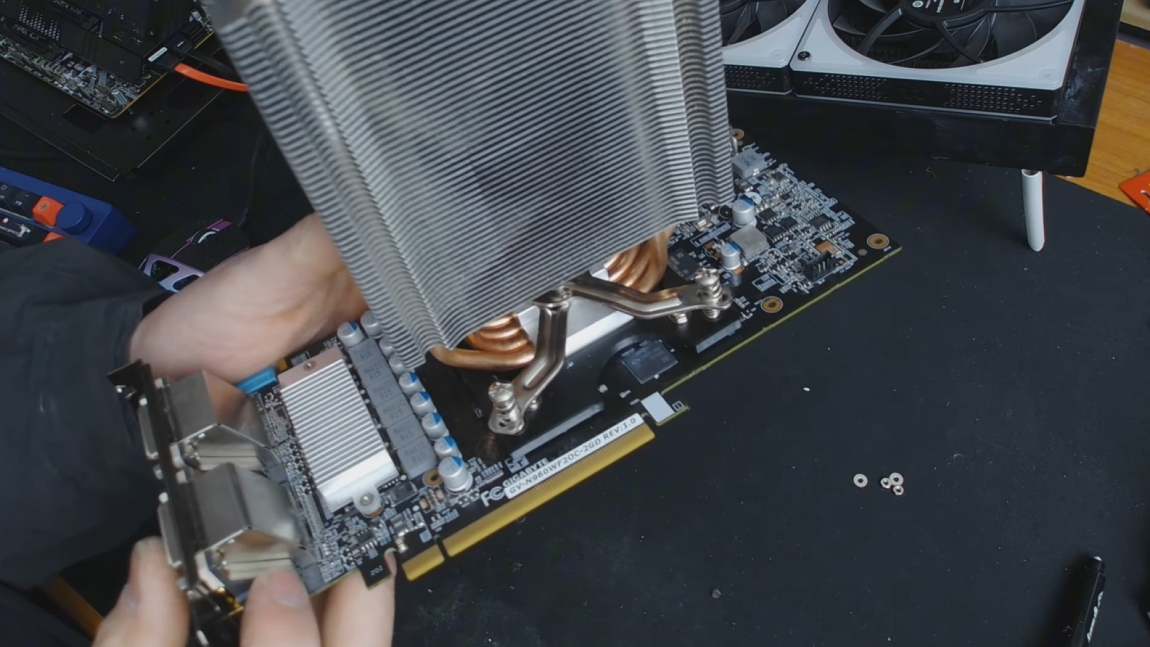
A YouTube modder and Redditor has successfully attached a CPU cooler to an Nvidia GTX 960 using a 3D-printed bracket, bringing temperatures compared to the stock cooler down by 10 degrees and breaking a 3DMark Fire Strike benchmark record in the process.
The daring tinkerer, whose modest YouTube channel trades under the name TrashBench, took to the platform to reveal how they used a CPU cooler, some zip ties, and eventually a 3D-printed bracket to create one of the most novel yet surprisingly effective GPU cooling solutions we've ever seen.
"Had a spare CPU cooler and figured I’d chuck it on my 960 for a laugh," they revealed on Reddit. The first solution? Remove the GTX 960's stock cooler and simply strap the CPU to the card using some zip ties. The video reveals a precariously poised Cooler Master heatsink bound by some luminous yellow cable ties, a hilariously rudimentary first attempt.
I tried zip-tying a CPU cooler to my GTX 960. It got hotter. So I made a mount. Now it’s colder than stock. from r/hardware
"It looked dumb, ran hot, and nearly rattled itself apart," TrashBench reveals. A second run of 3D Mark's Fire Strike test yielded temperature increases of more than 10 degrees, likely caused by poor contact with the GPU's heatsink.
Undeterred, TrashBench fired up the 3D printer and "whipped up a proper bracket." The third run with the 3D-printed mount finally showcased the awesome power of the CPU cooler when properly in contact with the GPU, delivering a 13-degree improvement over the GTX 960's stock cooler and a 20-degree improvement on the cable tie attempt.
What's more, the monstrous combination even broke the 3DMark Fire Strike record for GTX 960 and Intel Core i5-12600KF processors, with a new top overall score of 7642, beating out the previous record of 7458. Not only that, the CPU cooler solution runs quieter than the GTX 960's stock cooler, but TrashBench puts this down to the "trash" fan running at low speed.

While the hardware combination is something of an eyesore, the actual physics behind the performance makes perfect sense. GPU coolers, by nature, have a much lower profile than CPU air coolers, which are equipped with fins and can measure upwards of 15 centimeters in height. TrashBench confirmed the CPU cooler in play weighed 470 grams, compared to the 270-gram factory cooler taken from the GTX 960, a battle of physics with only one winner when it comes to shifting heat.
And TrashBench isn't done. "I think I'll have to try it on a 4080 next," they quipped at the end of the video. Engaging further on Reddit, TrashBench also agreed that a GPU with a more sophisticated cooling system (the 960 is from 2015, after all) might not yield such a drastic improvement, promising to try a more potent cooler on a 2070 Super. In fact, TrashBench is even considering more thorough benchmarking to weigh stock GPU coolers, comparing them directly with similar-sized CPU coolers for fairer testing, a project that might even give our GPU Benchmarks Hierarchy a run for its money!
You can watch the full two-minute video below.
Follow Tom's Hardware on Google News to get our up-to-date news, analysis, and reviews in your feeds. Make sure to click the Follow button.







